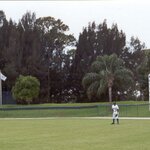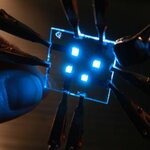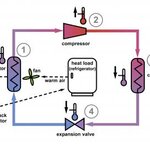Applied Physics

Important business has taken me out of sunny California and across the country to the slightly warmer March days of Florida; baseball spring training.
I maintain an affection for spring training even though I no longer live in a winter climate where a few days of sunshine after 5 months of cold can truly be appreciated. But I spent my childhood in Florida, in a baseball haven aptly called Dodgertown, so cold climate or not baseball in spring is a necessary ritual. It gives me a reminder I haven't seen my family in a year and spring baseball is somehow both better and worse…

Lighting consumes one-fifth of the electricity generated in the United States. Solid-state lighting offers tremendous potential to improve the situation – once major research challenges are overcome.
The most promising technology is the organic light-emitting diode, or OLED. These multi-layered devices produce light by running an electrical current through a specially engineered host material into which light-producing phosphorescent molecules are embedded or "doped." The white light envisioned for large-scale applications, such as rooms and buildings, consists of red, green and blue…

To look at Matthew Houdek, you could never tell he was born with virtually no left ear.
A surgery at Loyola University Health System made it possible for Houdek to be fitted with a prosthetic ear that looks just like the real thing.
Ear-nose-throat surgeon Dr. Sam Marzo implanted three small metal screws in the side of Houdek's head. Each screw is fitted with a magnet, and magnetic attraction holds the prosthetic ear in place.
It takes only a few seconds for Houdek to put his prosthetic ear on in the morning and take it off when he showers or goes to bed. It doesn't fall off, and it's much…

A new study from North Carolina State University shows that painted road markings, such as the lines separating traffic lanes, are significantly better at reflecting headlights in the direction that the paint was applied. This finding will help determine how states comply with new federal safety regulations and save money on painting their roadways.
The NC State researchers found that "retroreflectivity values" are higher in the direction of paint striping. "In other words," study co-author Dr. Joe Hummer says, "the paint reflects more light if you are following the painting truck than if you…

One subject I love to explore is how everyday technology depends upon some very deep theories either in pure or applied sciences that in their abstract form might be viewed at best as academic or at worst as science fiction. GPS is a prime example. GPS is perhaps the most revolutionary technology of the 20th century - as fundamental as the printing press. It represents access to everyone for cheap global navigation. The practical benefits are enormous. And, we are only seeing the beginning of the economic and entrepreneurial potential of this technology. …

When people think of a refrigerator, magnetism isn't necessarily the first thought that comes to their minds. We've all become accustomed to the loud humming noise of the compressor and blowing fan that keeps our food nicely chilled, and anybody with even a cursory knowledge of thermodynamics knows basically how their refrigerator keeps the temperature down. A new development in materials science, however, may render our current refrigeration design obsolete and lead to far more efficient designs.
Refrigerators are in need of an upgrade. They've worked basically the same way since they were…

Scientists can easily explain the structural order that makes steel and aluminium out of molten metal and they have discovered the molecular changes that take place as water turns to ice, but glass blowers have been plying their trade since the first century BC and we have only just begun to understand what makes molten glass solid.
One hundred and fifty years after the construction of Crystal Palace at the Great Exhibition, scientists at The University of Nottingham and the University of California, Berkeley in collaboration with the University of Bath, have presented an explanation of how…

If you've ever been to a windy beach or a snow-blown landscape, you may have noticed a useless-looking fence with a pile of snow or sand on one side. The fence looks useless because it's full of holes - they're usually about 50% porous - and you might wonder what on earth they could be meant to control. It turns out that in windy conditions such a fence can cause a buildup of snow (or sand) on the downwind side, and that these fences are commonly used to prevent snowdrift across roadways as well as provide a measure of control over where snow or sand might build up.
It seems counterintuitive…

2008 will be a little longer than you might have assumed at the beginning of the year. But not so much that you’ll be early for that New Year’s Eve party.
The spin of the Earth is slowing down. Not by much, only about 0.002 seconds a day (it actually varies), relative to our modern definition of the second. The varying rotation of the Earth is due to the cumulative effect of friction from the ocean's tides, the Moon’s orbital momentum, snow at the polar ice caps, the 23-degree tilt of the Earth, the atmosphere, solar wind, space dust and magnetic storms. In any case, the Earth does not rotate…

When many of us go to see a live performance of some kind, like a play or a concert, we are often mostly concerned with the quality of the performers. We've gone to hear the flowing sounds of the San Francisco Symphony or the clear voices of Broadway singers. But what many people overlook, and what may be the most expensive and time-consuming aspect of any musical or theater production, is the effect of room acoustics on the sound coming from the stage. Now, with the massive increases in computing power over the last decade or so, acousticians are able to predict far more accurately how a…